Evaluating Business Risks: SFL's Client Manager and PI Relationship
VerifiedAdded on 2020/06/06
|10
|3266
|288
Report
AI Summary
This report analyzes the potential risks faced by Santé Future Limited (SFL) due to the appointment of a client manager to handle its business with Pharmaceutique Inc (PI). The report evaluates financial, operational, strategic, and reputational risks arising from the client manager's decisions, such as prioritizing PI's orders, delaying payments, and offering special discounts. It discusses the impacts of these risks on SFL, including potential damage to customer loyalty, financial instability, and operational inefficiencies. The report recommends mitigation strategies, including risk prioritization, avoidance of high-risk initiatives, and the implementation of an information security management system to safeguard data. The report emphasizes the importance of a proactive approach to risk management, offering insights into how SFL can minimize threats and achieve its business objectives.
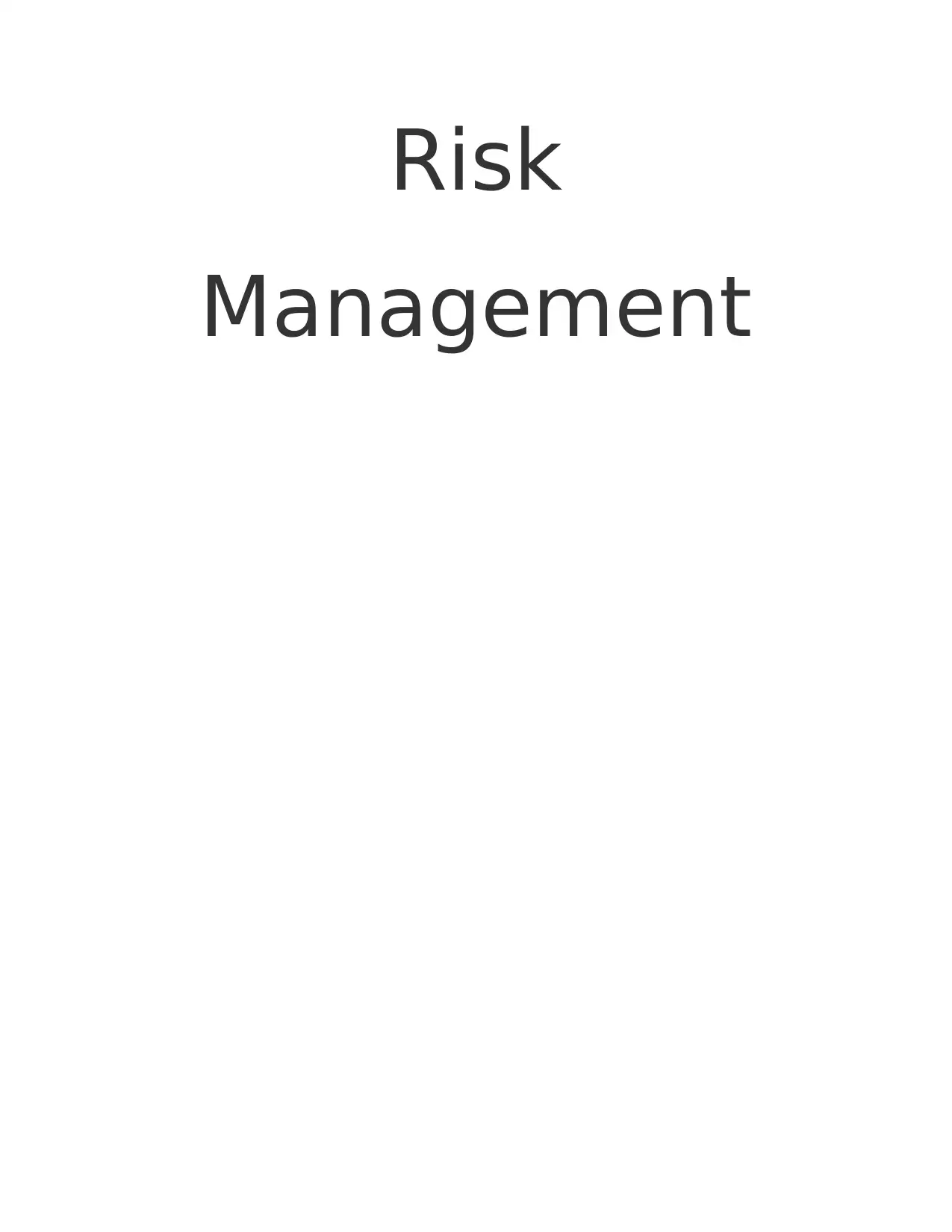
Risk
Management
Management
Paraphrase This Document
Need a fresh take? Get an instant paraphrase of this document with our AI Paraphraser
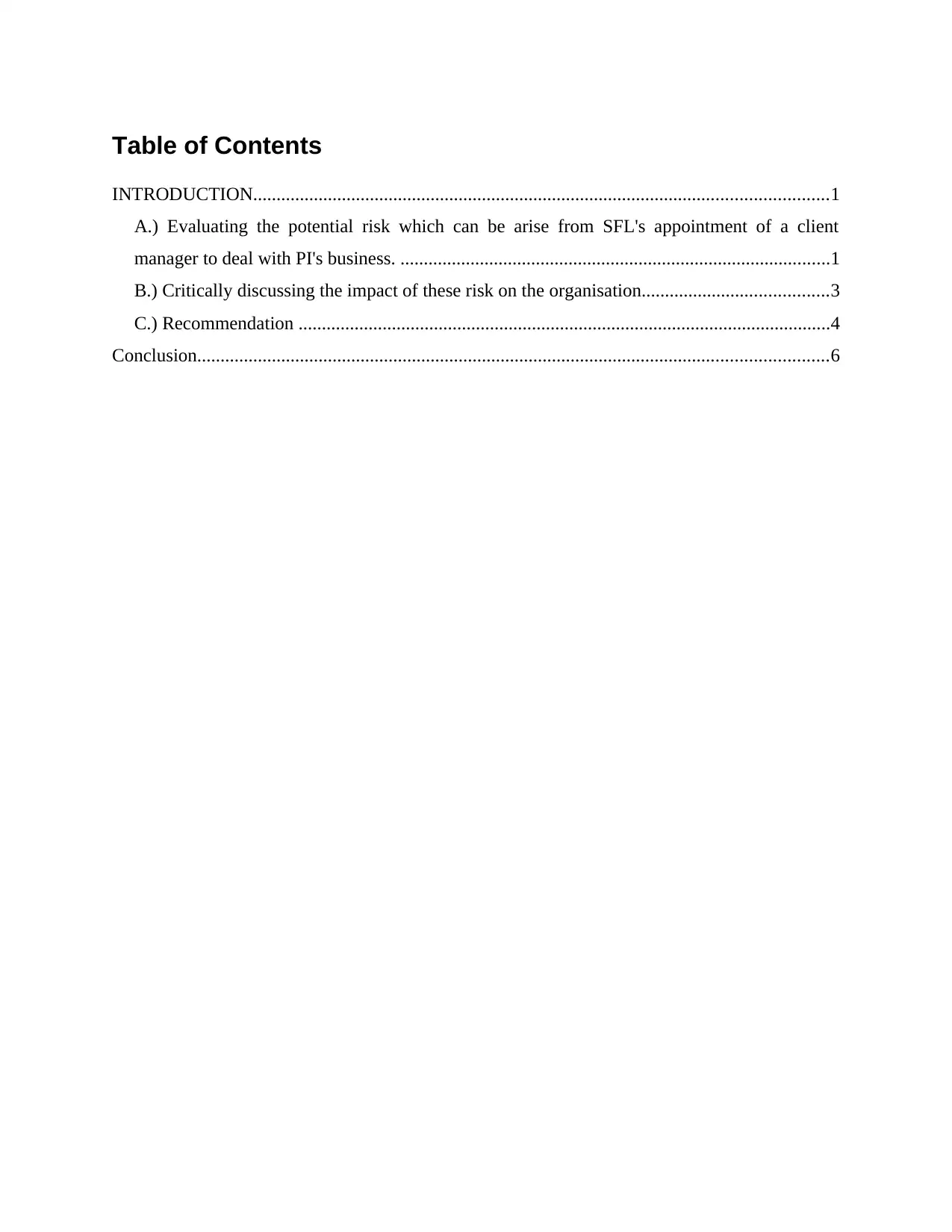
Table of Contents
INTRODUCTION...........................................................................................................................1
A.) Evaluating the potential risk which can be arise from SFL's appointment of a client
manager to deal with PI's business. ............................................................................................1
B.) Critically discussing the impact of these risk on the organisation........................................3
C.) Recommendation ..................................................................................................................4
Conclusion.......................................................................................................................................6
INTRODUCTION...........................................................................................................................1
A.) Evaluating the potential risk which can be arise from SFL's appointment of a client
manager to deal with PI's business. ............................................................................................1
B.) Critically discussing the impact of these risk on the organisation........................................3
C.) Recommendation ..................................................................................................................4
Conclusion.......................................................................................................................................6
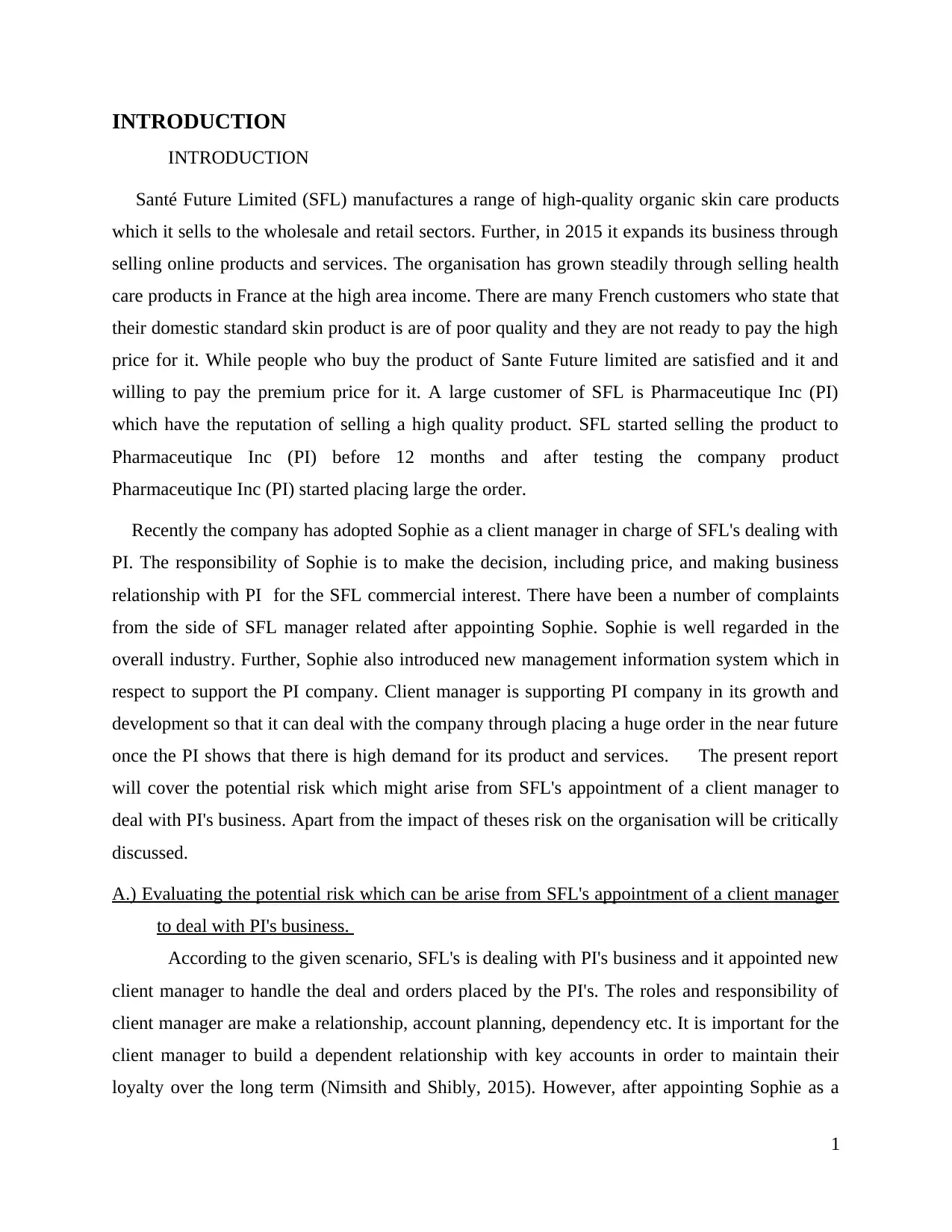
INTRODUCTION
INTRODUCTION
Santé Future Limited (SFL) manufactures a range of high-quality organic skin care products
which it sells to the wholesale and retail sectors. Further, in 2015 it expands its business through
selling online products and services. The organisation has grown steadily through selling health
care products in France at the high area income. There are many French customers who state that
their domestic standard skin product is are of poor quality and they are not ready to pay the high
price for it. While people who buy the product of Sante Future limited are satisfied and it and
willing to pay the premium price for it. A large customer of SFL is Pharmaceutique Inc (PI)
which have the reputation of selling a high quality product. SFL started selling the product to
Pharmaceutique Inc (PI) before 12 months and after testing the company product
Pharmaceutique Inc (PI) started placing large the order.
Recently the company has adopted Sophie as a client manager in charge of SFL's dealing with
PI. The responsibility of Sophie is to make the decision, including price, and making business
relationship with PI for the SFL commercial interest. There have been a number of complaints
from the side of SFL manager related after appointing Sophie. Sophie is well regarded in the
overall industry. Further, Sophie also introduced new management information system which in
respect to support the PI company. Client manager is supporting PI company in its growth and
development so that it can deal with the company through placing a huge order in the near future
once the PI shows that there is high demand for its product and services. The present report
will cover the potential risk which might arise from SFL's appointment of a client manager to
deal with PI's business. Apart from the impact of theses risk on the organisation will be critically
discussed.
A.) Evaluating the potential risk which can be arise from SFL's appointment of a client manager
to deal with PI's business.
According to the given scenario, SFL's is dealing with PI's business and it appointed new
client manager to handle the deal and orders placed by the PI's. The roles and responsibility of
client manager are make a relationship, account planning, dependency etc. It is important for the
client manager to build a dependent relationship with key accounts in order to maintain their
loyalty over the long term (Nimsith and Shibly, 2015). However, after appointing Sophie as a
1
INTRODUCTION
Santé Future Limited (SFL) manufactures a range of high-quality organic skin care products
which it sells to the wholesale and retail sectors. Further, in 2015 it expands its business through
selling online products and services. The organisation has grown steadily through selling health
care products in France at the high area income. There are many French customers who state that
their domestic standard skin product is are of poor quality and they are not ready to pay the high
price for it. While people who buy the product of Sante Future limited are satisfied and it and
willing to pay the premium price for it. A large customer of SFL is Pharmaceutique Inc (PI)
which have the reputation of selling a high quality product. SFL started selling the product to
Pharmaceutique Inc (PI) before 12 months and after testing the company product
Pharmaceutique Inc (PI) started placing large the order.
Recently the company has adopted Sophie as a client manager in charge of SFL's dealing with
PI. The responsibility of Sophie is to make the decision, including price, and making business
relationship with PI for the SFL commercial interest. There have been a number of complaints
from the side of SFL manager related after appointing Sophie. Sophie is well regarded in the
overall industry. Further, Sophie also introduced new management information system which in
respect to support the PI company. Client manager is supporting PI company in its growth and
development so that it can deal with the company through placing a huge order in the near future
once the PI shows that there is high demand for its product and services. The present report
will cover the potential risk which might arise from SFL's appointment of a client manager to
deal with PI's business. Apart from the impact of theses risk on the organisation will be critically
discussed.
A.) Evaluating the potential risk which can be arise from SFL's appointment of a client manager
to deal with PI's business.
According to the given scenario, SFL's is dealing with PI's business and it appointed new
client manager to handle the deal and orders placed by the PI's. The roles and responsibility of
client manager are make a relationship, account planning, dependency etc. It is important for the
client manager to build a dependent relationship with key accounts in order to maintain their
loyalty over the long term (Nimsith and Shibly, 2015). However, after appointing Sophie as a
1
⊘ This is a preview!⊘
Do you want full access?
Subscribe today to unlock all pages.

Trusted by 1+ million students worldwide
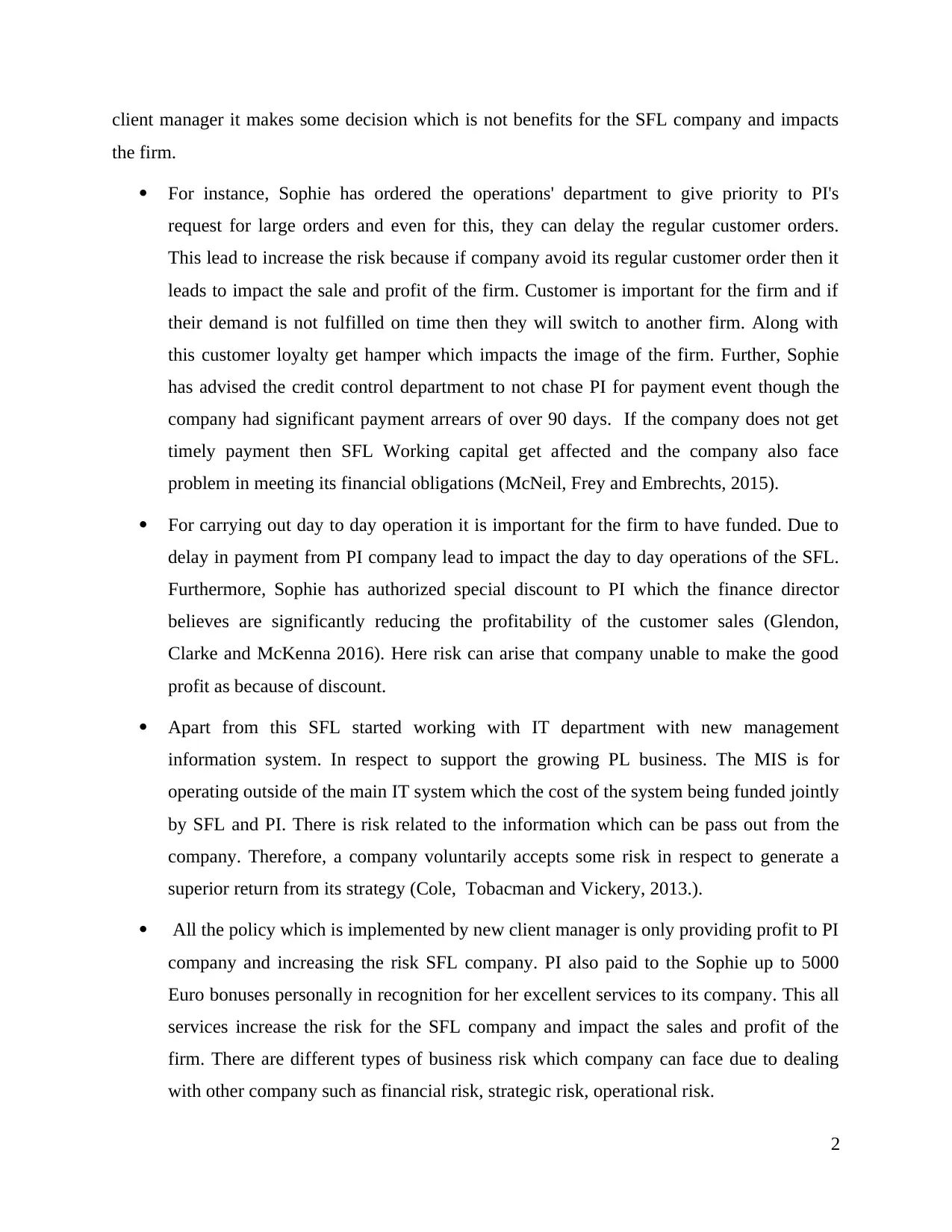
client manager it makes some decision which is not benefits for the SFL company and impacts
the firm.
For instance, Sophie has ordered the operations' department to give priority to PI's
request for large orders and even for this, they can delay the regular customer orders.
This lead to increase the risk because if company avoid its regular customer order then it
leads to impact the sale and profit of the firm. Customer is important for the firm and if
their demand is not fulfilled on time then they will switch to another firm. Along with
this customer loyalty get hamper which impacts the image of the firm. Further, Sophie
has advised the credit control department to not chase PI for payment event though the
company had significant payment arrears of over 90 days. If the company does not get
timely payment then SFL Working capital get affected and the company also face
problem in meeting its financial obligations (McNeil, Frey and Embrechts, 2015).
For carrying out day to day operation it is important for the firm to have funded. Due to
delay in payment from PI company lead to impact the day to day operations of the SFL.
Furthermore, Sophie has authorized special discount to PI which the finance director
believes are significantly reducing the profitability of the customer sales (Glendon,
Clarke and McKenna 2016). Here risk can arise that company unable to make the good
profit as because of discount.
Apart from this SFL started working with IT department with new management
information system. In respect to support the growing PL business. The MIS is for
operating outside of the main IT system which the cost of the system being funded jointly
by SFL and PI. There is risk related to the information which can be pass out from the
company. Therefore, a company voluntarily accepts some risk in respect to generate a
superior return from its strategy (Cole, Tobacman and Vickery, 2013.).
All the policy which is implemented by new client manager is only providing profit to PI
company and increasing the risk SFL company. PI also paid to the Sophie up to 5000
Euro bonuses personally in recognition for her excellent services to its company. This all
services increase the risk for the SFL company and impact the sales and profit of the
firm. There are different types of business risk which company can face due to dealing
with other company such as financial risk, strategic risk, operational risk.
2
the firm.
For instance, Sophie has ordered the operations' department to give priority to PI's
request for large orders and even for this, they can delay the regular customer orders.
This lead to increase the risk because if company avoid its regular customer order then it
leads to impact the sale and profit of the firm. Customer is important for the firm and if
their demand is not fulfilled on time then they will switch to another firm. Along with
this customer loyalty get hamper which impacts the image of the firm. Further, Sophie
has advised the credit control department to not chase PI for payment event though the
company had significant payment arrears of over 90 days. If the company does not get
timely payment then SFL Working capital get affected and the company also face
problem in meeting its financial obligations (McNeil, Frey and Embrechts, 2015).
For carrying out day to day operation it is important for the firm to have funded. Due to
delay in payment from PI company lead to impact the day to day operations of the SFL.
Furthermore, Sophie has authorized special discount to PI which the finance director
believes are significantly reducing the profitability of the customer sales (Glendon,
Clarke and McKenna 2016). Here risk can arise that company unable to make the good
profit as because of discount.
Apart from this SFL started working with IT department with new management
information system. In respect to support the growing PL business. The MIS is for
operating outside of the main IT system which the cost of the system being funded jointly
by SFL and PI. There is risk related to the information which can be pass out from the
company. Therefore, a company voluntarily accepts some risk in respect to generate a
superior return from its strategy (Cole, Tobacman and Vickery, 2013.).
All the policy which is implemented by new client manager is only providing profit to PI
company and increasing the risk SFL company. PI also paid to the Sophie up to 5000
Euro bonuses personally in recognition for her excellent services to its company. This all
services increase the risk for the SFL company and impact the sales and profit of the
firm. There are different types of business risk which company can face due to dealing
with other company such as financial risk, strategic risk, operational risk.
2
Paraphrase This Document
Need a fresh take? Get an instant paraphrase of this document with our AI Paraphraser
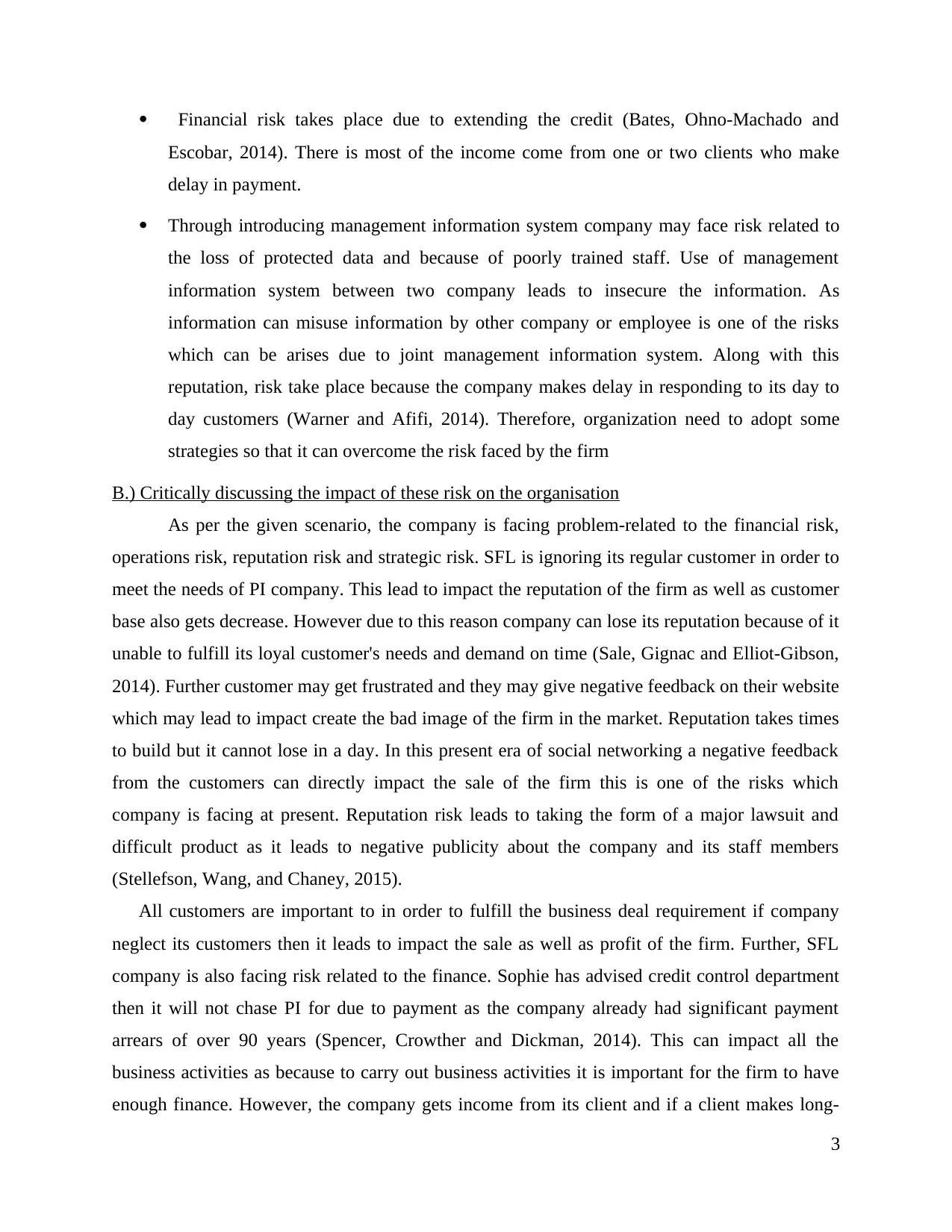
Financial risk takes place due to extending the credit (Bates, Ohno-Machado and
Escobar, 2014). There is most of the income come from one or two clients who make
delay in payment.
Through introducing management information system company may face risk related to
the loss of protected data and because of poorly trained staff. Use of management
information system between two company leads to insecure the information. As
information can misuse information by other company or employee is one of the risks
which can be arises due to joint management information system. Along with this
reputation, risk take place because the company makes delay in responding to its day to
day customers (Warner and Afifi, 2014). Therefore, organization need to adopt some
strategies so that it can overcome the risk faced by the firm
B.) Critically discussing the impact of these risk on the organisation
As per the given scenario, the company is facing problem-related to the financial risk,
operations risk, reputation risk and strategic risk. SFL is ignoring its regular customer in order to
meet the needs of PI company. This lead to impact the reputation of the firm as well as customer
base also gets decrease. However due to this reason company can lose its reputation because of it
unable to fulfill its loyal customer's needs and demand on time (Sale, Gignac and Elliot-Gibson,
2014). Further customer may get frustrated and they may give negative feedback on their website
which may lead to impact create the bad image of the firm in the market. Reputation takes times
to build but it cannot lose in a day. In this present era of social networking a negative feedback
from the customers can directly impact the sale of the firm this is one of the risks which
company is facing at present. Reputation risk leads to taking the form of a major lawsuit and
difficult product as it leads to negative publicity about the company and its staff members
(Stellefson, Wang, and Chaney, 2015).
All customers are important to in order to fulfill the business deal requirement if company
neglect its customers then it leads to impact the sale as well as profit of the firm. Further, SFL
company is also facing risk related to the finance. Sophie has advised credit control department
then it will not chase PI for due to payment as the company already had significant payment
arrears of over 90 years (Spencer, Crowther and Dickman, 2014). This can impact all the
business activities as because to carry out business activities it is important for the firm to have
enough finance. However, the company gets income from its client and if a client makes long-
3
Escobar, 2014). There is most of the income come from one or two clients who make
delay in payment.
Through introducing management information system company may face risk related to
the loss of protected data and because of poorly trained staff. Use of management
information system between two company leads to insecure the information. As
information can misuse information by other company or employee is one of the risks
which can be arises due to joint management information system. Along with this
reputation, risk take place because the company makes delay in responding to its day to
day customers (Warner and Afifi, 2014). Therefore, organization need to adopt some
strategies so that it can overcome the risk faced by the firm
B.) Critically discussing the impact of these risk on the organisation
As per the given scenario, the company is facing problem-related to the financial risk,
operations risk, reputation risk and strategic risk. SFL is ignoring its regular customer in order to
meet the needs of PI company. This lead to impact the reputation of the firm as well as customer
base also gets decrease. However due to this reason company can lose its reputation because of it
unable to fulfill its loyal customer's needs and demand on time (Sale, Gignac and Elliot-Gibson,
2014). Further customer may get frustrated and they may give negative feedback on their website
which may lead to impact create the bad image of the firm in the market. Reputation takes times
to build but it cannot lose in a day. In this present era of social networking a negative feedback
from the customers can directly impact the sale of the firm this is one of the risks which
company is facing at present. Reputation risk leads to taking the form of a major lawsuit and
difficult product as it leads to negative publicity about the company and its staff members
(Stellefson, Wang, and Chaney, 2015).
All customers are important to in order to fulfill the business deal requirement if company
neglect its customers then it leads to impact the sale as well as profit of the firm. Further, SFL
company is also facing risk related to the finance. Sophie has advised credit control department
then it will not chase PI for due to payment as the company already had significant payment
arrears of over 90 years (Spencer, Crowther and Dickman, 2014). This can impact all the
business activities as because to carry out business activities it is important for the firm to have
enough finance. However, the company gets income from its client and if a client makes long-
3
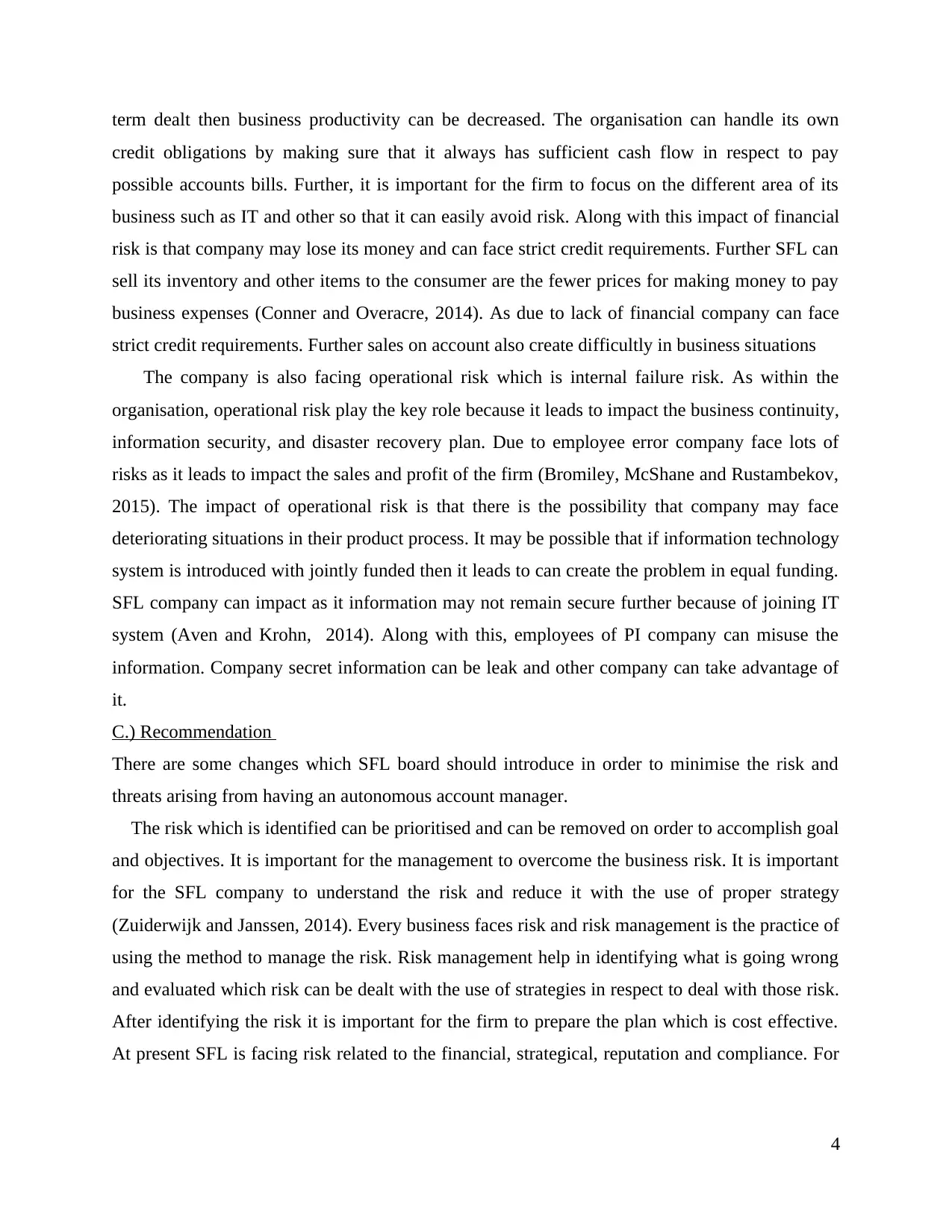
term dealt then business productivity can be decreased. The organisation can handle its own
credit obligations by making sure that it always has sufficient cash flow in respect to pay
possible accounts bills. Further, it is important for the firm to focus on the different area of its
business such as IT and other so that it can easily avoid risk. Along with this impact of financial
risk is that company may lose its money and can face strict credit requirements. Further SFL can
sell its inventory and other items to the consumer are the fewer prices for making money to pay
business expenses (Conner and Overacre, 2014). As due to lack of financial company can face
strict credit requirements. Further sales on account also create difficultly in business situations
The company is also facing operational risk which is internal failure risk. As within the
organisation, operational risk play the key role because it leads to impact the business continuity,
information security, and disaster recovery plan. Due to employee error company face lots of
risks as it leads to impact the sales and profit of the firm (Bromiley, McShane and Rustambekov,
2015). The impact of operational risk is that there is the possibility that company may face
deteriorating situations in their product process. It may be possible that if information technology
system is introduced with jointly funded then it leads to can create the problem in equal funding.
SFL company can impact as it information may not remain secure further because of joining IT
system (Aven and Krohn, 2014). Along with this, employees of PI company can misuse the
information. Company secret information can be leak and other company can take advantage of
it.
C.) Recommendation
There are some changes which SFL board should introduce in order to minimise the risk and
threats arising from having an autonomous account manager.
The risk which is identified can be prioritised and can be removed on order to accomplish goal
and objectives. It is important for the management to overcome the business risk. It is important
for the SFL company to understand the risk and reduce it with the use of proper strategy
(Zuiderwijk and Janssen, 2014). Every business faces risk and risk management is the practice of
using the method to manage the risk. Risk management help in identifying what is going wrong
and evaluated which risk can be dealt with the use of strategies in respect to deal with those risk.
After identifying the risk it is important for the firm to prepare the plan which is cost effective.
At present SFL is facing risk related to the financial, strategical, reputation and compliance. For
4
credit obligations by making sure that it always has sufficient cash flow in respect to pay
possible accounts bills. Further, it is important for the firm to focus on the different area of its
business such as IT and other so that it can easily avoid risk. Along with this impact of financial
risk is that company may lose its money and can face strict credit requirements. Further SFL can
sell its inventory and other items to the consumer are the fewer prices for making money to pay
business expenses (Conner and Overacre, 2014). As due to lack of financial company can face
strict credit requirements. Further sales on account also create difficultly in business situations
The company is also facing operational risk which is internal failure risk. As within the
organisation, operational risk play the key role because it leads to impact the business continuity,
information security, and disaster recovery plan. Due to employee error company face lots of
risks as it leads to impact the sales and profit of the firm (Bromiley, McShane and Rustambekov,
2015). The impact of operational risk is that there is the possibility that company may face
deteriorating situations in their product process. It may be possible that if information technology
system is introduced with jointly funded then it leads to can create the problem in equal funding.
SFL company can impact as it information may not remain secure further because of joining IT
system (Aven and Krohn, 2014). Along with this, employees of PI company can misuse the
information. Company secret information can be leak and other company can take advantage of
it.
C.) Recommendation
There are some changes which SFL board should introduce in order to minimise the risk and
threats arising from having an autonomous account manager.
The risk which is identified can be prioritised and can be removed on order to accomplish goal
and objectives. It is important for the management to overcome the business risk. It is important
for the SFL company to understand the risk and reduce it with the use of proper strategy
(Zuiderwijk and Janssen, 2014). Every business faces risk and risk management is the practice of
using the method to manage the risk. Risk management help in identifying what is going wrong
and evaluated which risk can be dealt with the use of strategies in respect to deal with those risk.
After identifying the risk it is important for the firm to prepare the plan which is cost effective.
At present SFL is facing risk related to the financial, strategical, reputation and compliance. For
4
⊘ This is a preview!⊘
Do you want full access?
Subscribe today to unlock all pages.

Trusted by 1+ million students worldwide
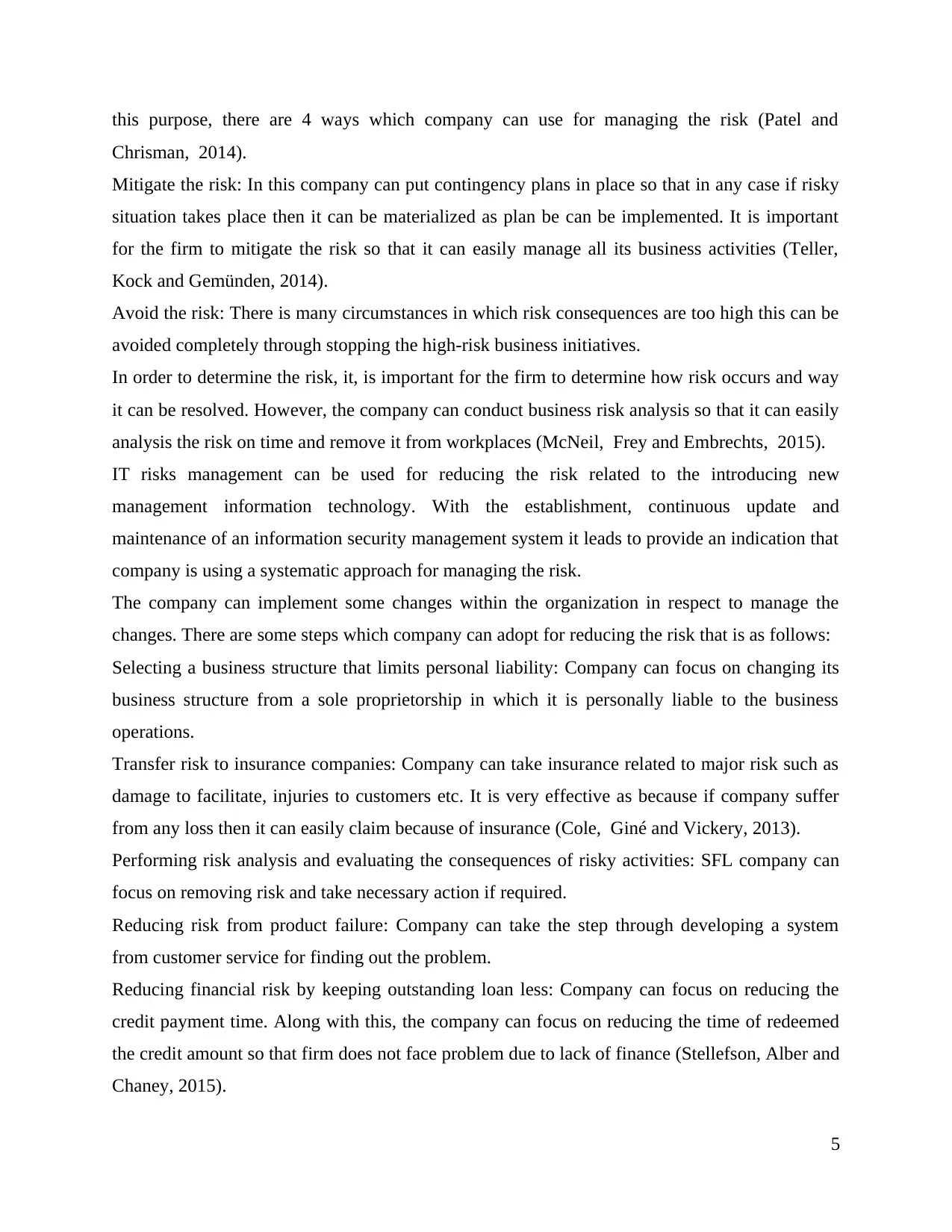
this purpose, there are 4 ways which company can use for managing the risk (Patel and
Chrisman, 2014).
Mitigate the risk: In this company can put contingency plans in place so that in any case if risky
situation takes place then it can be materialized as plan be can be implemented. It is important
for the firm to mitigate the risk so that it can easily manage all its business activities (Teller,
Kock and Gemünden, 2014).
Avoid the risk: There is many circumstances in which risk consequences are too high this can be
avoided completely through stopping the high-risk business initiatives.
In order to determine the risk, it, is important for the firm to determine how risk occurs and way
it can be resolved. However, the company can conduct business risk analysis so that it can easily
analysis the risk on time and remove it from workplaces (McNeil, Frey and Embrechts, 2015).
IT risks management can be used for reducing the risk related to the introducing new
management information technology. With the establishment, continuous update and
maintenance of an information security management system it leads to provide an indication that
company is using a systematic approach for managing the risk.
The company can implement some changes within the organization in respect to manage the
changes. There are some steps which company can adopt for reducing the risk that is as follows:
Selecting a business structure that limits personal liability: Company can focus on changing its
business structure from a sole proprietorship in which it is personally liable to the business
operations.
Transfer risk to insurance companies: Company can take insurance related to major risk such as
damage to facilitate, injuries to customers etc. It is very effective as because if company suffer
from any loss then it can easily claim because of insurance (Cole, Giné and Vickery, 2013).
Performing risk analysis and evaluating the consequences of risky activities: SFL company can
focus on removing risk and take necessary action if required.
Reducing risk from product failure: Company can take the step through developing a system
from customer service for finding out the problem.
Reducing financial risk by keeping outstanding loan less: Company can focus on reducing the
credit payment time. Along with this, the company can focus on reducing the time of redeemed
the credit amount so that firm does not face problem due to lack of finance (Stellefson, Alber and
Chaney, 2015).
5
Chrisman, 2014).
Mitigate the risk: In this company can put contingency plans in place so that in any case if risky
situation takes place then it can be materialized as plan be can be implemented. It is important
for the firm to mitigate the risk so that it can easily manage all its business activities (Teller,
Kock and Gemünden, 2014).
Avoid the risk: There is many circumstances in which risk consequences are too high this can be
avoided completely through stopping the high-risk business initiatives.
In order to determine the risk, it, is important for the firm to determine how risk occurs and way
it can be resolved. However, the company can conduct business risk analysis so that it can easily
analysis the risk on time and remove it from workplaces (McNeil, Frey and Embrechts, 2015).
IT risks management can be used for reducing the risk related to the introducing new
management information technology. With the establishment, continuous update and
maintenance of an information security management system it leads to provide an indication that
company is using a systematic approach for managing the risk.
The company can implement some changes within the organization in respect to manage the
changes. There are some steps which company can adopt for reducing the risk that is as follows:
Selecting a business structure that limits personal liability: Company can focus on changing its
business structure from a sole proprietorship in which it is personally liable to the business
operations.
Transfer risk to insurance companies: Company can take insurance related to major risk such as
damage to facilitate, injuries to customers etc. It is very effective as because if company suffer
from any loss then it can easily claim because of insurance (Cole, Giné and Vickery, 2013).
Performing risk analysis and evaluating the consequences of risky activities: SFL company can
focus on removing risk and take necessary action if required.
Reducing risk from product failure: Company can take the step through developing a system
from customer service for finding out the problem.
Reducing financial risk by keeping outstanding loan less: Company can focus on reducing the
credit payment time. Along with this, the company can focus on reducing the time of redeemed
the credit amount so that firm does not face problem due to lack of finance (Stellefson, Alber and
Chaney, 2015).
5
Paraphrase This Document
Need a fresh take? Get an instant paraphrase of this document with our AI Paraphraser
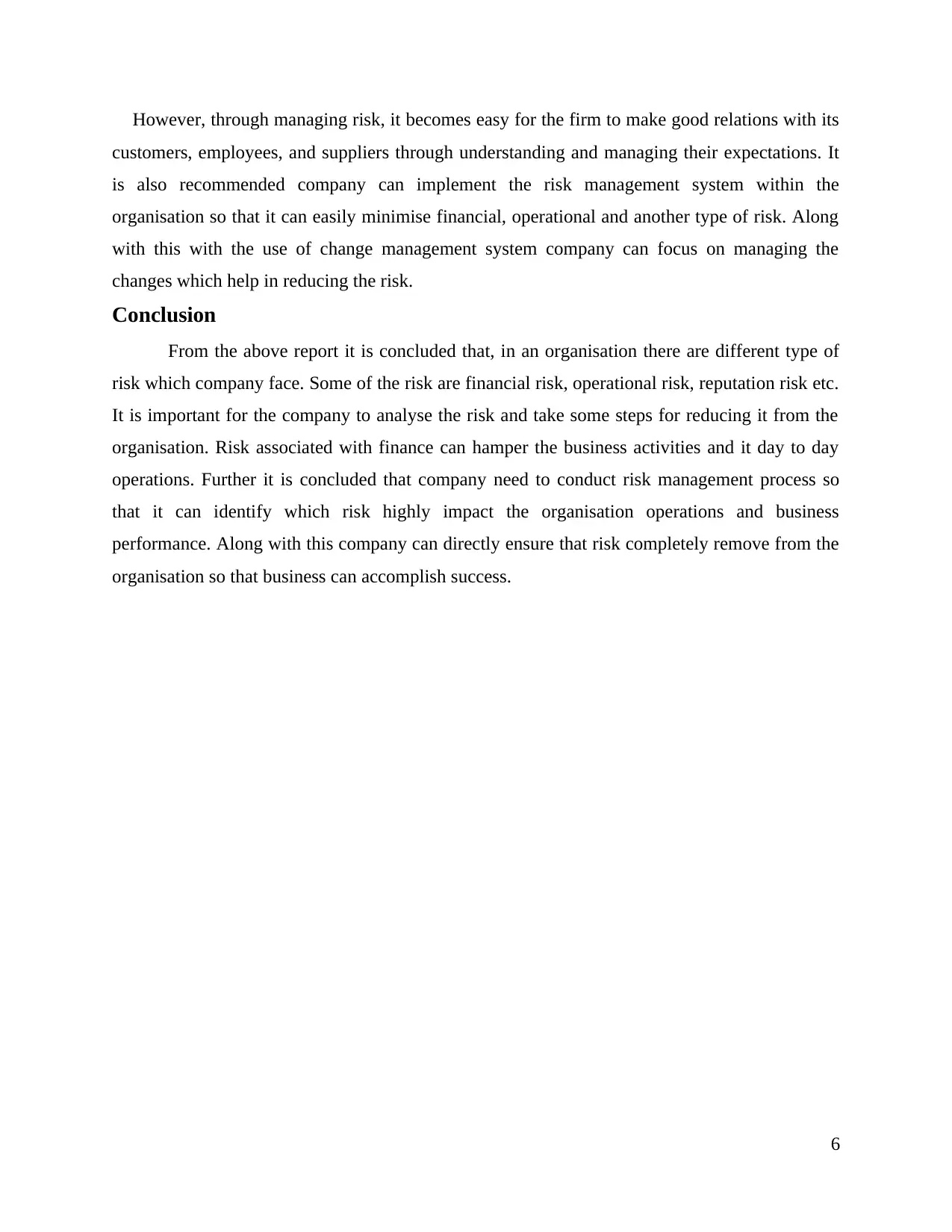
However, through managing risk, it becomes easy for the firm to make good relations with its
customers, employees, and suppliers through understanding and managing their expectations. It
is also recommended company can implement the risk management system within the
organisation so that it can easily minimise financial, operational and another type of risk. Along
with this with the use of change management system company can focus on managing the
changes which help in reducing the risk.
Conclusion
From the above report it is concluded that, in an organisation there are different type of
risk which company face. Some of the risk are financial risk, operational risk, reputation risk etc.
It is important for the company to analyse the risk and take some steps for reducing it from the
organisation. Risk associated with finance can hamper the business activities and it day to day
operations. Further it is concluded that company need to conduct risk management process so
that it can identify which risk highly impact the organisation operations and business
performance. Along with this company can directly ensure that risk completely remove from the
organisation so that business can accomplish success.
6
customers, employees, and suppliers through understanding and managing their expectations. It
is also recommended company can implement the risk management system within the
organisation so that it can easily minimise financial, operational and another type of risk. Along
with this with the use of change management system company can focus on managing the
changes which help in reducing the risk.
Conclusion
From the above report it is concluded that, in an organisation there are different type of
risk which company face. Some of the risk are financial risk, operational risk, reputation risk etc.
It is important for the company to analyse the risk and take some steps for reducing it from the
organisation. Risk associated with finance can hamper the business activities and it day to day
operations. Further it is concluded that company need to conduct risk management process so
that it can identify which risk highly impact the organisation operations and business
performance. Along with this company can directly ensure that risk completely remove from the
organisation so that business can accomplish success.
6
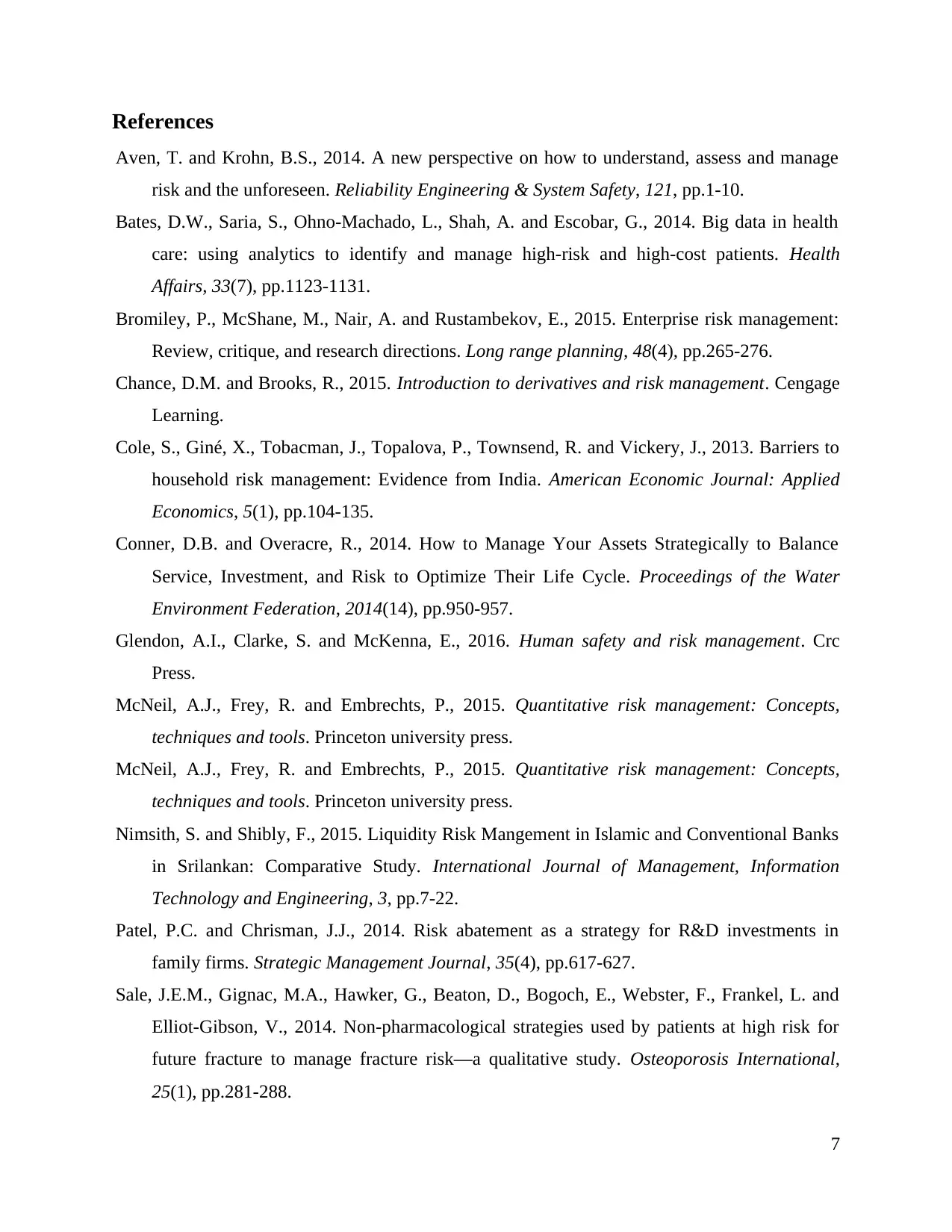
References
Aven, T. and Krohn, B.S., 2014. A new perspective on how to understand, assess and manage
risk and the unforeseen. Reliability Engineering & System Safety, 121, pp.1-10.
Bates, D.W., Saria, S., Ohno-Machado, L., Shah, A. and Escobar, G., 2014. Big data in health
care: using analytics to identify and manage high-risk and high-cost patients. Health
Affairs, 33(7), pp.1123-1131.
Bromiley, P., McShane, M., Nair, A. and Rustambekov, E., 2015. Enterprise risk management:
Review, critique, and research directions. Long range planning, 48(4), pp.265-276.
Chance, D.M. and Brooks, R., 2015. Introduction to derivatives and risk management. Cengage
Learning.
Cole, S., Giné, X., Tobacman, J., Topalova, P., Townsend, R. and Vickery, J., 2013. Barriers to
household risk management: Evidence from India. American Economic Journal: Applied
Economics, 5(1), pp.104-135.
Conner, D.B. and Overacre, R., 2014. How to Manage Your Assets Strategically to Balance
Service, Investment, and Risk to Optimize Their Life Cycle. Proceedings of the Water
Environment Federation, 2014(14), pp.950-957.
Glendon, A.I., Clarke, S. and McKenna, E., 2016. Human safety and risk management. Crc
Press.
McNeil, A.J., Frey, R. and Embrechts, P., 2015. Quantitative risk management: Concepts,
techniques and tools. Princeton university press.
McNeil, A.J., Frey, R. and Embrechts, P., 2015. Quantitative risk management: Concepts,
techniques and tools. Princeton university press.
Nimsith, S. and Shibly, F., 2015. Liquidity Risk Mangement in Islamic and Conventional Banks
in Srilankan: Comparative Study. International Journal of Management, Information
Technology and Engineering, 3, pp.7-22.
Patel, P.C. and Chrisman, J.J., 2014. Risk abatement as a strategy for R&D investments in
family firms. Strategic Management Journal, 35(4), pp.617-627.
Sale, J.E.M., Gignac, M.A., Hawker, G., Beaton, D., Bogoch, E., Webster, F., Frankel, L. and
Elliot-Gibson, V., 2014. Non-pharmacological strategies used by patients at high risk for
future fracture to manage fracture risk—a qualitative study. Osteoporosis International,
25(1), pp.281-288.
7
Aven, T. and Krohn, B.S., 2014. A new perspective on how to understand, assess and manage
risk and the unforeseen. Reliability Engineering & System Safety, 121, pp.1-10.
Bates, D.W., Saria, S., Ohno-Machado, L., Shah, A. and Escobar, G., 2014. Big data in health
care: using analytics to identify and manage high-risk and high-cost patients. Health
Affairs, 33(7), pp.1123-1131.
Bromiley, P., McShane, M., Nair, A. and Rustambekov, E., 2015. Enterprise risk management:
Review, critique, and research directions. Long range planning, 48(4), pp.265-276.
Chance, D.M. and Brooks, R., 2015. Introduction to derivatives and risk management. Cengage
Learning.
Cole, S., Giné, X., Tobacman, J., Topalova, P., Townsend, R. and Vickery, J., 2013. Barriers to
household risk management: Evidence from India. American Economic Journal: Applied
Economics, 5(1), pp.104-135.
Conner, D.B. and Overacre, R., 2014. How to Manage Your Assets Strategically to Balance
Service, Investment, and Risk to Optimize Their Life Cycle. Proceedings of the Water
Environment Federation, 2014(14), pp.950-957.
Glendon, A.I., Clarke, S. and McKenna, E., 2016. Human safety and risk management. Crc
Press.
McNeil, A.J., Frey, R. and Embrechts, P., 2015. Quantitative risk management: Concepts,
techniques and tools. Princeton university press.
McNeil, A.J., Frey, R. and Embrechts, P., 2015. Quantitative risk management: Concepts,
techniques and tools. Princeton university press.
Nimsith, S. and Shibly, F., 2015. Liquidity Risk Mangement in Islamic and Conventional Banks
in Srilankan: Comparative Study. International Journal of Management, Information
Technology and Engineering, 3, pp.7-22.
Patel, P.C. and Chrisman, J.J., 2014. Risk abatement as a strategy for R&D investments in
family firms. Strategic Management Journal, 35(4), pp.617-627.
Sale, J.E.M., Gignac, M.A., Hawker, G., Beaton, D., Bogoch, E., Webster, F., Frankel, L. and
Elliot-Gibson, V., 2014. Non-pharmacological strategies used by patients at high risk for
future fracture to manage fracture risk—a qualitative study. Osteoporosis International,
25(1), pp.281-288.
7
⊘ This is a preview!⊘
Do you want full access?
Subscribe today to unlock all pages.

Trusted by 1+ million students worldwide
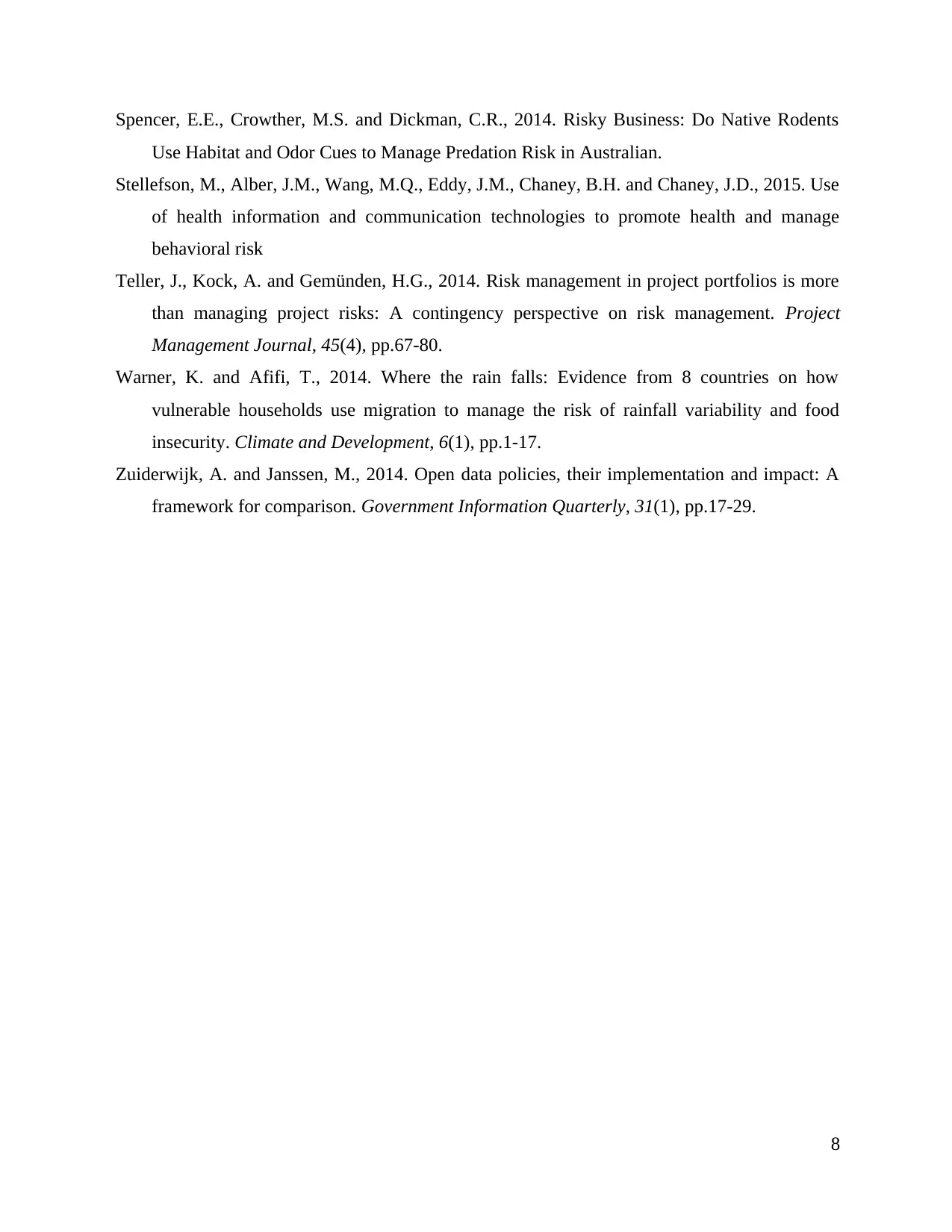
Spencer, E.E., Crowther, M.S. and Dickman, C.R., 2014. Risky Business: Do Native Rodents
Use Habitat and Odor Cues to Manage Predation Risk in Australian.
Stellefson, M., Alber, J.M., Wang, M.Q., Eddy, J.M., Chaney, B.H. and Chaney, J.D., 2015. Use
of health information and communication technologies to promote health and manage
behavioral risk
Teller, J., Kock, A. and Gemünden, H.G., 2014. Risk management in project portfolios is more
than managing project risks: A contingency perspective on risk management. Project
Management Journal, 45(4), pp.67-80.
Warner, K. and Afifi, T., 2014. Where the rain falls: Evidence from 8 countries on how
vulnerable households use migration to manage the risk of rainfall variability and food
insecurity. Climate and Development, 6(1), pp.1-17.
Zuiderwijk, A. and Janssen, M., 2014. Open data policies, their implementation and impact: A
framework for comparison. Government Information Quarterly, 31(1), pp.17-29.
8
Use Habitat and Odor Cues to Manage Predation Risk in Australian.
Stellefson, M., Alber, J.M., Wang, M.Q., Eddy, J.M., Chaney, B.H. and Chaney, J.D., 2015. Use
of health information and communication technologies to promote health and manage
behavioral risk
Teller, J., Kock, A. and Gemünden, H.G., 2014. Risk management in project portfolios is more
than managing project risks: A contingency perspective on risk management. Project
Management Journal, 45(4), pp.67-80.
Warner, K. and Afifi, T., 2014. Where the rain falls: Evidence from 8 countries on how
vulnerable households use migration to manage the risk of rainfall variability and food
insecurity. Climate and Development, 6(1), pp.1-17.
Zuiderwijk, A. and Janssen, M., 2014. Open data policies, their implementation and impact: A
framework for comparison. Government Information Quarterly, 31(1), pp.17-29.
8
1 out of 10
Related Documents
Your All-in-One AI-Powered Toolkit for Academic Success.
+13062052269
info@desklib.com
Available 24*7 on WhatsApp / Email
![[object Object]](/_next/static/media/star-bottom.7253800d.svg)
Unlock your academic potential
Copyright © 2020–2025 A2Z Services. All Rights Reserved. Developed and managed by ZUCOL.





